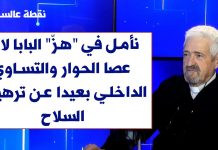اعلان الحكومة بـ30 وزيرا وباسيل للخارجية والحسن للداخلية وبو صعب للدفاع والجراح للاعلام
الوكالة الوطنية/31 كانون الثاني/19
صدرت اليوم ثلاثة مراسيم تتعلق بقبول استقالة حكومة الرئيس سعد الدين الحريري وتسمية الرئيس سعد الحريري رئيسا لمجلس الوزراء، وتشكيلة الحكومة الجديدة. ووقع المرسومين الأولين رئيس الجمهورية العماد ميشال عون، فيما وقع المرسوم الثالث الرئيسين عون والحريري.
مرسوم قبول الاستقالة
وقد أذاع المراسيم الأمين العام لرئاسة مجلس الوزراء فؤاد فليفل، وجاء في نص مرسوم قبول استقالة حكومة سعد الدين الحريري والذي يحمل الرقم 4338، ما يأتي: “ان رئيس الجمهورية, بناء على الدستور, لا سيما البند 5 من المادة 53 منه، والفقرة (هـ) من البند واحد من المادة 69 منه, بناء على الاستقالة المقدمة من قبل رئيس مجلس الوزراء السيد سعد الدين الحريري، يرسم ما يأتي:
المادة الاولى: اعتبرت الحكومة التي يرئسها السيد سعد الدين الجريري مستقيلة.
المادة الثانية: ينشر هذا المرسوم ويبلغ حيث تدعو الحاجة ويعمل به فور صدوره”.
بعبدا في 31 كانون الثاني 2019
رئيس الجمهورية العماد ميشال عون
مرسوم تسمية الرئيس الحريري
وجاء في المرسوم الرقم 4339 تسمية السيد سعد الدين الحريري رئيسا لمجلس الوزراء: “ان رئيس الجمهورية, بناء على الدستور لا سيما البند 3 من المادة 53 منه, بناء على المرسوم رقم 4338 تاريخ31 كانون الثاني 2019 المتضمن اعتبار الحكومة التي يرئسها السيد سعد الدين الحريري مستقيلة, يرسم ما يأتي:
المادة الاولى: يسمى السيد سعد الدين الحريري رئيسا لمجلس الوزراء.
المادة الثانية: ينشر هذا المرسوم ويبلغ حيث تدعو الحاجة ويعمل به فور صدوره”.
بعبدا في 31 كانون الثاني 2019
رئيس الجمهورية العماد ميشال عون
مرسوم تشكيل الحكومة
أما مرسوم تشكيل الحكومة الذي حمل الرقم 4340 ، فنص على الآتي: “ان رئيس الجمهورية بناء على الدستور لا سيما البند 4 من المادة 53 منه, بناء على المرسوم رقم 4339 المتضمن تسمية السيد سعد الحريري رئيسا لمجلس الوزراء, بناء على اقتراح رئيس مجلس الوزراء، يرسم ما يأتي:
المادة الاولى: عين السادة:
سعد الدين الحريري رئيسا لمجلس الوزراء،
– غسان حاصباني نائبا لرئيس مجلس الوزراء،
– أكرم شهيب وزيرا للتربية والتعليم العالي،
– علي حسن خليل وزيرا للمالية،
– محمد فنيش وزيرا للشباب والرياضة،
– جبران باسيل وزيرا للخارجية والمغتربين،
– وائل بو فاعور وزيرا للصناعة،
– ريا حفار الحسن وزيرا للداخلية والبلديات،
– سليم جريصاتي وزير دولة لشؤون رئاسة الجمهورية،
– الياس بو صعب وزيرا للدفاع الوطني،
– جمال الجراح وزيرا للاعلام،
– يوسف فنيانوس وزيرا للأشغال العامة والنقل،
– اواديس كيدانيان وزيرا للسياحة،
– ألبير سرحان وزيرا للعدل،
– محمود قماطي وزير دولة لشؤون مجلس النواب،
– منصور بطيش وزيرا للاقتصاد والتجارة،
– جميل صبحي جبق وزيرا للصحة،
– كميل ابو سليمان وزيرا للعمل،
– ريشار قيومجيان وزيرا للشؤون الاجتماعية،
– مي شدياق وزير دولة لشؤون التنمية الادارية،
– حسن اللقيس وزيرا للزراعة،
– محمد شقير وزيرا للاتصالات،
– عادل أفيوني وزير دولة لشؤون تكنولوجيا المعلومات،
– فادي جريصاتي وزيرا للبيئة،
– غسان عطالله وزيرا للمهجرين،
– حسن مراد وزير دولة للشؤون التجارة الخارجية،
– صالح الغريب وزير دولة لشؤون النازحين،
– محمد داوود داوود وزيرا للثقافة،
– فيوليت خيرالله وزيرة دولة لشؤون تأهيل الاجتماعي والاقتصادي للشباب والمرأة،
– ندى بستاني وزيرا للطاقة والمياه،
المادة الثانية: ينشر هذا المرسوم ويبلغ حيث تدعو الحاجة ويعمل به فور صدوره”.
بعبدا في 31 كانون الثاني 2019.
صدر عن رئيس الجمهورية العماد ميشال عون ورئيس مجلس الوزراء سعد الحريري.
Hariri’s New Government Announced after Nine Months of Delay
Naharnet/January 31/19/
The line-up of Prime Minister Saad Hariri’s new government was announced on Thursday, following around nine months of strenuous negotiations that involved several obstacles.
Hariri presented the line-up to President Michel Aoun after Lebanese Forces leader Samir Geagea accepted to cede the culture portfolio to Speaker Nabih Berri and a long-running obstacle over the representation of the Hizbullah-backed Consultative Gathering was resolved.
Below is the cabinet’s line-up as recited by Council of Ministers Secretary General Fouad Fleifel:
– Prime Minister: Saad Hariri (al-Mustaqbal Movement)
– Deputy PM: Ghassan Hasbani (Lebanese Forces)
– Foreign Affairs: Jebran Bassil (Free Patriotic Movement / President Aoun)
– Defense: Elias Bou Saab (FPM / Aoun)
– Justice: Albert Serhan (FPM / Aoun)
– Economy: Mansour Bteish (FPM / Aoun)
– Energy: Nada al-Bustani (FPM / Aoun)
– Environment: Fadi Jreissati (FPM / Aoun)
– Presidency Affairs: Salim Jreissati (FPM / Aoun)
– Displaced: Ghassan Atallah (FPM / Aoun)
– State Minister for Foreign Trade Affairs: Hassan Mrad (Consultative Gathering / Aoun)
– Tourism: Avedis Guidanian (Tashnag Party)
– State Minister for Refugee Affairs: Saleh al-Gharib (Lebanese Democratic Party)
– Health Minister: Jamil Jabaq (Hizbullah)
– Sport and Youth: Mohammed Fneish (Hizbullah)
– State Minister for Parliament Affairs: Mahmoud Qmati (Hizbullah)
– Education: Akram Shehayyeb (Progressive Socialist Party)
– Industry: Wael Abu Faour (PSP)
– State Minister for Information Technology Affairs: Adel al-Afiouni (Miqati’s bloc)
– Interior: Raya al-Hassan (Mustaqbal)
– Public Works: Youssef Fenianos (Marada Movement)
– Labor: Camille Abu Suleiman (Lebanese Forces)
– State Minister for Administrative Development: May Chidiac (LF)
– Finance: Ali Hassan Khalil (AMAL Movement)
– Culture: Mohammed Daoud (AMAL)
– Telecommunications: Mohammed Shuqeir (Mustaqbal)
– Social Affairs: Richard Kouyoumjian (LF)
– Agriculture: Hassan al-Laqqis (AMAL)
– Information: Jamal al-Jarrah (Mustaqbal)
– State Minister for Social and Economic Rehabilitation of Youth and Women: Violet Khairallah Safadi (Mustaqbal)
– State Minister for Administrative Development Affairs: May Chidiac (LF)
Addressing the Lebanese after the line-up’s announcement, Hariri apologized to citizens over the delay and noted that the country is facing “economic, financial and service-related challenges in addition to the Israeli threats.”“I’m counting on everyone’s cooperation,” he added.
“Cooperation is a must so that we rise to the level of the challenges in order to overcome this period,” Hariri went on to say, stressing that “the solution lies in bold reforms, not in nagging or populist speeches.” Hariri also revealed that a session to draft the ministerial policy statement will be held at noon Saturday. The issue of representing the Hizbullah-backed Consultative Gathering, a grouping of six Sunni MPs, had delayed the formation of the government for the past four months. Previous disagreements over Christian and Druze representation had also hindered the formation process before being eventually resolved. Late Thursday, fireworks resounded in the Lebanese capital. A new government will be able to unlock billions of dollars in aid pledged at a conference in April, notably to help boost the country’s ailing infrastructure.
In 2009, it took Hariri five months to form a government, while his successor Tammam Salam took a whole ten months after he was nominated in 2013.
After its formation, the new government now has 30 days to draw up a ministerial declaration to outline its priorities before it starts working. This too could prove to be difficult, in view of internal divisions. Contentious issues include Lebanon’s relations with Syria’s Assad, the future of around one million Syrian refugees in a country of 4.5 million, and Hizbullah’s weapons arsenal.
Analysts says the new cabinet’s main challenge will be the economy. Lebanon’s service-oriented economy had looked on the brink of collapse for some time, but a Paris conference dubbed CEDRE in April made aid pledges worth $11 billion. It is one of the world’s most indebted countries, with public debt estimated at 141 percent of gross domestic product in 2018, according to Moody’s Investors Service.





















